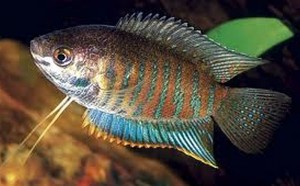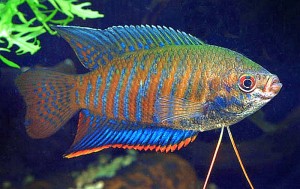The Banded Gourami (Colisa fasciata) is found in Northern India, Pakistan, Assam, Burma, Bangladesh and Myammar.
Also recognized as Trichogaster fasciata, the Banded Gourami, is a tropical labyrinth fish that prefers the shallower weedy environments of ponds, ditches, lakes, large rivers, and other slow moving waters covered with surface vegetation.
In many parts of India and Pakistan, Banded Gourami are used for food and aquacultured in the rice paddies as a secondary means of income for local farmers. The fish grow to almost 5″ in length with females being a bit smaller.
Like all lybrinth fishes, Banded Gourami can breathe atmospheric air with their maze like lybrinth organ which allows it to survive in the rice paddies and oxygen depleted waters where they are often found.
Male Banded Gourami have an orange body color with iridescent blue stripes, a caudal fin with blue spots at the base, and bright red spots towards the end. The anal fin is colored an iridescent blue, with red edges at the end of the spines.
Adult males develop pointed anal and dorsal fins. Several color variations are known and are apparently dependent on geographical location.
Females have the same basic color patterns but, like the Dwarf Gourami, are a more pale grey. They also have a rounded anal fin.
Banded Gourami are a shy peaceful species that are perfect candidates for most peaceful community aquariums.
Although they can be aggressive when spawning, males will usually only squabble among themselves or fish that are similarly colored. They get along well with barbs, danios, rasboras, most loaches and the smaller Bagrid catfish.
In a large aquarium, they can be housed with other gourami species however, they have been known to hybridize with the Thick Lipped Gourami (Colisa labiosa).
Banded Gourami do best in a quiet, dimly lit, heavily planted tank with plenty of floating plants for shade. A fine dark gravel or sandy substrate should be provided with some driftwood
roots and plenty of places for them to hide.
They do not like strong currents or bright lighting, so keep water movement to a minimum and only provide enough light for the plants to grow. They prefer slightly acidic water but are tolerant of a wide range of water conditions. This species is very timid, scares easily, and takes some time to adapt to conditions in the aquarium, so choose their tank mates carefully.
With a dark substrate and low lighting, they will develop beautiful colors at a par with Colisa labiosa.
Banded Gourami are bubble nest builders and easy to breed in an aquarium environment. Keep the sexes separate and feed them plenty of live or frozen food for a few weeks before breeding them. Set up a separate breeding tank with a dark sandy substrate and a water level not more than 8″ deep. Add plenty of floating plants as well as some fine leaved plants like cabomba, to provide additional cover for the female. The pH should be about 5.5 to 6.5 and the temperature should be raised to about 82 degrees F. Use a sponge corner bubble filter but keep water movement to a minimum.
When the female is noticeably gravid with eggs, place her into the breeding tank and add the male a couple of days later. The male’s colors will intensify almost immediately and he will start to construct a bubble nest among the floating plants. When the female is ready to spawn, she will approach the nest and the male will wrap his body around her to spawn. As the eggs are released and begin to sink, the male will gather them in his mouth and blow them back into the nest. Several spawning will occur until 500 to 1000 eggs are produced.
When spawning has been completed, remove the female from the tank. The male will tend to the eggs and the fry, but when they hatch out in approximately 24 to 36 hours, it is best to remove the male.
At this point, it is important to keep a tight fitting cover on the breeding tank to ensure high humidity levels, so the labyrinth organs of the tiny fry can develop properly.
In another three days, the fry will be free swimming and should be fed infusoria or liquid fry food until they can eat newly hatched baby brine shrimp, , and powdered flake food.
Banded Gourami are omnivorous and very easy to feed. In addition to a quality flake food, they should be offered live, frozen, and freeze dried foods to get the best colors from the fish.
Banded Gourami are occasionally available to tropical fish keeping enthusiasts at a size of between 1 1/2″ to 2 1/2″.
Minimum Tank Size: 20 gallons
Care Level: Moderate
Temperament: Shy, Peaceful
Aquarium Hardiness: Moderately Hardy
Water Conditions: 70-82°F, 4-15°dH , pH 6.0-7.5
Max Size: 4″
Color Form: Orange, Blue, Red
Diet: Omnivore
Compatibility: Good community tank fish
Origin: India, Pakistan, Burma
Family: Osphronemidae
Lifespan: 5-8 years
Aquarist Experience Level: Intermediate




